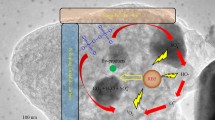Abstract
Previous studies showed that Cu/SBA-15-[N] had an excellent simultaneous adsorption–oxidation performance of hydrogen sulfide (H2S) and hydrogen phosphide (PH3), but the regeneration of deactivated Cu/SBA-15-[N] is still a difficult problem. In this work, acid pickling treatment (Rm-A), water washing (Ram-W), calcination (Rm-C) and acid pickling after calcining (Rm-CA) methods were used to study the regeneration performance of the deactivated Cu/SBA-15-[N]. The results showed that the most effective method was Rm-CA. Under optimal regeneration conditions (calcination temperature = 450 °C, HNO3 mass fraction = 13%), the sulfur capacity (23.73 mgS/g) and phosphorus capacity (100.49 mgP/g) of regenerated Cu/SBA-15-[N] were close to the fresh Cu/SBA-15-[N] (47.38 mgS/g, 136.42 mgP/g). The in situ IR indicated that the surface products of the sorbent were mainly in the form of oxides after calcination, these substances are transformed into the corresponding active components under the action of nitric acid. BET, XRD and TGA results indicated that the regeneration process did not destroy the deactivated Cu/SBA-15-[N] structure, but could change the surface of the group composition. The results of XPS reveal the copper content in different samples. After 3 times regeneration, the sulfur capacity and the phosphorus capacity of regenerated Cu/SBA-15-[N] could reach to 20.67 mgS/g and 88.43 mgP/g, which indicated that the Rm-CA method had good stability for the recovery of adsorption activity. This study provided an effective regeneration method that could also reduce the environmental hazards of deactivated Cu/SBA-15-[N].














Similar content being viewed by others
References
K.A. Brenneman, R.A. James, E.A. Gross, D.C. Dorman, Toxicol. Pathol. 28, 326 (2000)
D.C. Dorman, Toxicol. Sci. 65, 18 (2002)
S. Gullane, O. Hamdaoui, Desalin. Water Treat. 3994, 1 (2015)
J. Saiz, E. Bringas, I. Ortiz, Ind. Eng. Chem. Res. 53, 18928 (2014)
S. Garg, V.C. Srivastava, S. Singh, T.K. Mandal, Int. J. Chem. React. Eng. 13, 437 (2015)
H. Yan, W. Chen, G. Liao, X. Li, S. Ma, L. Li, Sep. Purif. Technol. 159, 1 (2016)
S. Srivastava, P. Mohanty, J.K. Parikh, A.K. Dalai, S.S. Amritphale, A.K. Khare, Cuihua Xuebao/Chin. J. Catal. 36, 933 (2015)
X. Duan, W. Liu, L. Yue, W. Fu, M.N. Ha, J. Li, G. Lu, Dalt. Trans. 44, 17381 (2015)
E.I. Basaldella, J.C. Tara, G.A. Armenta, M.E.P. Iglesias, J. Porous Mater. 14, 273 (2007)
B. Levasseur, A.M. Ebrahim, T.J. Bandosz, J. Colloid Interface Sci. 377, 347 (2012)
S. Li, K. Li, J. Hao, P. Ning, L. Tang, X. Sun, Chem. Eng. J. 302, 69 (2016)
T.C. Drage, A. Arenillas, K.M. Smith, C.E. Snape, Microporous Mesoporous Mater. 116, 504 (2008)
X. Song, S. Li, K. Li, Microporous Mesoporous Mater. 2017, S1387181117306571 (2017)
F. Salvador, N. Martin-Sanchez, R. Sanchez-Hernandez, M.J. Sanchez-Montero, C. Izquierdo, Microporous Mesoporous Mater. 202, 259 (2015)
M. Mureddu, I. Ferino, E. Rombi, M.G. Cutrufello, P. Deiana, A. Ardu, A. Musinu, G. Piccaluga, C. Cannas, Fuel 102, 691 (2012)
L. Wu, F. Ye, D. Lei D, Pet. Sci. (2018)
S.Y. Jung, S.J. Lee, T.J. Lee, Catal. Today 111(3–4), 217 (2006)
S. Lata, P.K. Singh, S.R. Samadder, Int. J. Environ. Sci. Technol. 12, 1461 (2015)
Y. Peng, J. Li, X. Huang, X. Li, W. Su, X. Sun, D. Wang, J. Hao, Environ. Sci. Technol. 48, 4515 (2014)
D. Zhao, Science 279, 548 (1998)
R. Zubrzycki, T. Ressler, Microporous Mesoporous Mater. 214, 8 (2015)
C. Pirez, J.C. Morin, J.C. Manayil, A.F. Lee, K. Wilson, Microporous Mesoporous Mater. 271, 196 (2018)
M. Harisekhar, V. Pavan, S. Shanthi, J. Chem. Technol. Biotechnol. 90(10), 1906 (2015)
S. Karthikeyan, M.P. Pachamuthu, M.A. Isaacs, Appl. Catal. B 199, 323 (2016)
W. Shen, D. Mao, Z. Luo, RSC Adv. 7(44), 27689 (2017)
L. Wang, J.K. Yao, Z. Wang, H.J. Jiao, J. Qi, X.J. Yong, D.H. Liu, Plasma Sci. Technol. 20(10), 101001 (2018)
E. Da, A. Sayari, Desalination 277(1), 54 (2011)
Acknowledgements
This work was supported by the National Natural Science Foundation of China (41807373, 21667015, and 51708266), and National Key R&D Program of China (2018YFC0213400).
Author information
Authors and Affiliations
Corresponding authors
Ethics declarations
Conflict of interest
The authors declare that they have no conflict of interest.
Additional information
Publisher's Note
Springer Nature remains neutral with regard to jurisdictional claims in published maps and institutional affiliations.
Rights and permissions
About this article
Cite this article
Feng, J., Li, K., Li, S. et al. Regeneration of the exhausted mesoporous Cu/SBA-15-[N] for simultaneous adsorption–oxidation of hydrogen sulfide and phosphine. Res Chem Intermed 46, 329–346 (2020). https://doi.org/10.1007/s11164-019-03953-7
Received:
Accepted:
Published:
Issue Date:
DOI: https://doi.org/10.1007/s11164-019-03953-7




